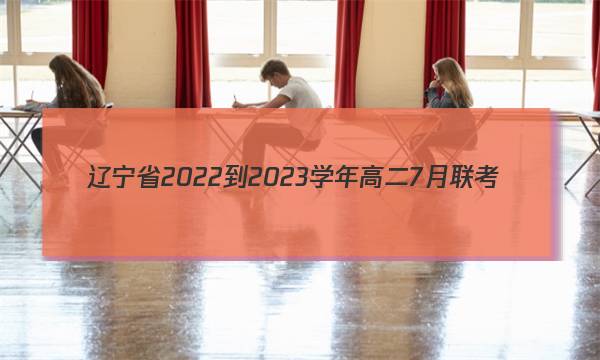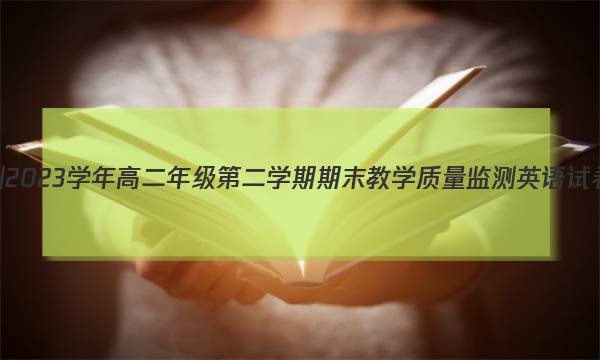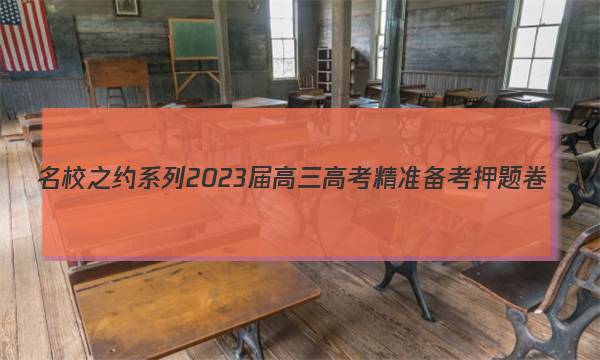2023年衡水金卷先享题·高三一轮复习夯基卷(河北专版) 地理(一)1答案

2023年衡水金卷先享题·高三一轮复习夯基卷(河北专版) 地理(一)1答案,目前我们已经整理了2023年衡水金卷先享题·高三一轮复习夯基卷(河北专版) 地理(一)1答案的各科答案和试卷,更多试卷答案请关注本答案网。

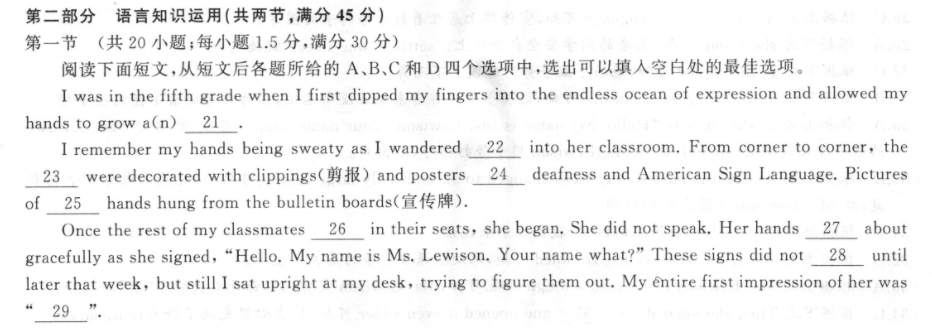
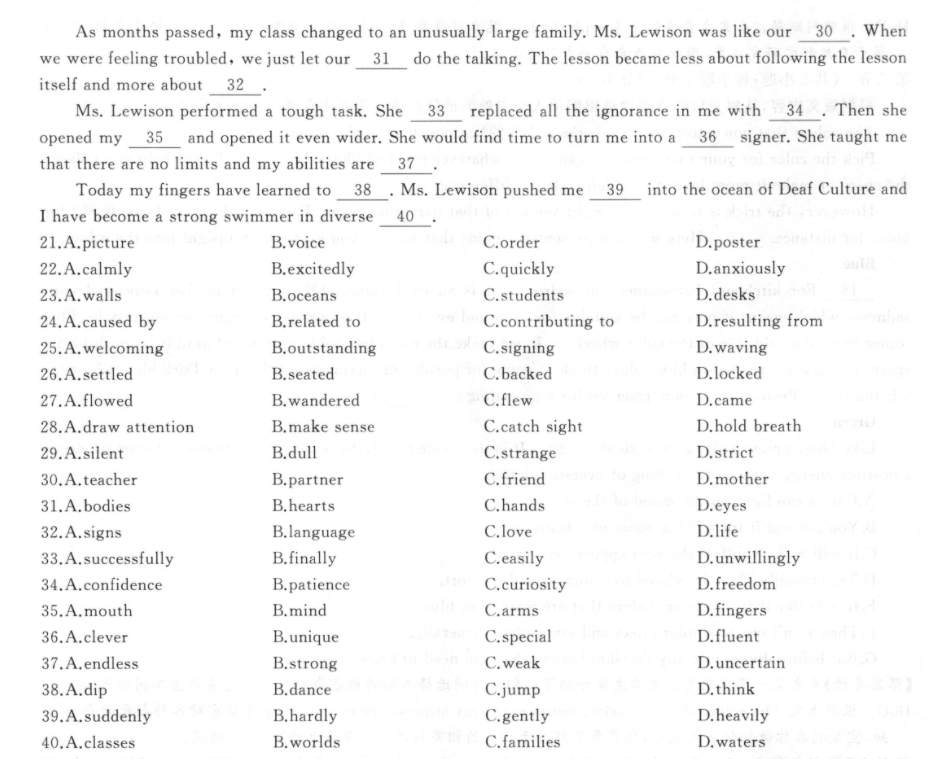
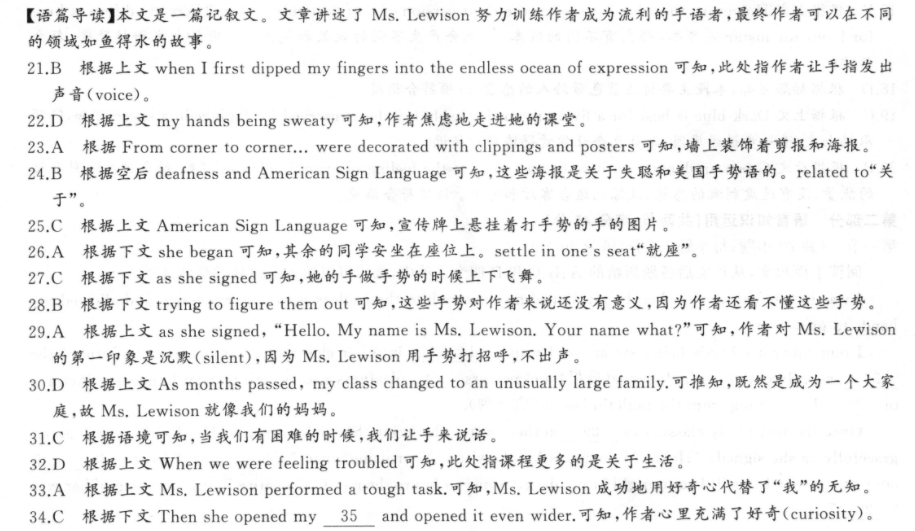

第二部分语言知识运用(共两节,满分45分)】第一节(共20小题;每小题1.5分,满分30分)阅读下面短文,从短文后各题所给的A、B、C和D四个选项中,选出可以填入空白处的最佳选项。I was in the fifth grade when I first dipped my fingers into the endless ocean of expression and allowed myhands to grow a(n)21.I remember my hands being sweaty as I wandered 22 into her classroom.From corner to corner,the23 were decorated with clippings()and posters 24 deafness and American Sign Language.Picturesof25 hands hung from the bulletin boards(宣传牌).Once the rest of my classmates 26 in their seats,she began.She did not speak.Her hands 27 aboutgracefully as she signed,"Hello.My name is Ms.Lewison.Your name what?"These signs did not 28untillater that week,but still I sat upright at my desk,trying to figure them out.My entire first impression of her was“29”.As months passed,my class changed to an unusually large family.Ms.Lewison was like our 30.Whenwe were feeling troubled,we just let our 31 do the talking.The lesson became less about following the lessonitself and more about 32.Ms.Lewison performed a tough task.She 33 replaced all the ignorance in me with 34.Then sheopened my 35 and opened it even wider.She would find time to turn me into a 36 signer.She taught methat there are no limits and my abilities are 37Today my fingers have learned to 38.Ms.Lewison pushed me 39into the ocean of Deaf Culture andI have become a strong swimmer in diverse4021.A.pictureB.voiceC.orderD.poster22.A.calmlyB.excitedlyC.quicklyD.anxiously23.A.wallsB.oceansC.studentsD.desks24.A.caused byB.related toC.contributing toD.resulting from25.A.welcomingB.outstandingC.signingD.waving26.A.settledB.seatedC.backedD.locked27.A.flowedB.wanderedC.flewD.came28.A.draw attentionB.make senseC.catch sightD.hold breath29.A.silentB.dullC.strangeD.strict30.A.teacherB.partnerC.friendD.mother31.A.bodiesB.heartsC.handsD.eyes32.A.signsB.languageC.loveD.life33.A.successfullyB.finallyC.easilyD.unwillingly34.A.confidenceB.patienceC.curiosityD.freedom35.A.mouthB.mindC.armsD.fingers36.A.cleverB.uniqueC.specialD.fluent37.A.endlessB.strongC.weakD.uncertain38.A.dipB.danceC.jumpD.think39.A.suddenlyB.hardlyC.gentlyD.heavily40.A.classesB.worldsC.familiesD.waters【语篇导读】本文是一篇记叙文。文章讲述了Ms.Lewison努力训练作者成为流利的手语者,最终作者可以在不同的领域如鱼得水的故事。2l.B根据上文when I first dipped my fingers into the endless ocean of expression可知,此处指作者让手指发出声音(voice).。22.D根据上文my hands being sweaty可知,作者焦虑地走进她的课堂。23.A根据From corner to corner..were decorated with clippings and posters可知,墙上装饰着剪报和海报。24.B根据空后deafness and American Sign Language可知,这些海报是关于失聪和美国手势语的。related to“关于”。25.C根据上文American Sign Language可知,宣传牌上悬挂着打手势的手的图片。26.A根据下文she began可知,其余的同学安坐在座位上。settle in one's seat“就座”。27.C根据下文as she signed可知,她的手做手势的时候上下飞舞。28.B根据下文trying to figure them out可知,这些手势对作者来说还没有意义,因为作者还看不懂这些手势。29.A根据上文as she signed,“Hello..My name is Ms.Lewison.Your name what?”可知,作者对Ms.Lewison的第一印象是沉默(silent),因为Ms.Lewison用手势打招呼,不出声。30.D根据上文As months passed,my class changed to an unusually large family..可推知,既然是成为一个大家庭,故Ms.Lewison就像我们的妈妈。31.C根据语境可知,当我们有困难的时候,我们让手来说话。32.D根据上文When we were feeling troubled可知,此处指课程更多的是关于生活。33.A根据上文Ms.Lewison performed a tough task.可知,Ms.Lewison成功地用好奇心代替了“我”的无知。34.C根据下文Then she opened my35 and opened it even wider.可知,作者心里充满了好奇(curiosity)。35.B根据上文replaced all the ignorance in me with34可知,她打开了作者的思想。36.D结合语境可知,此处应是fluent'“流利的”。37.A根据上文there are no limits可知,她告诉“我”没有限制,“我”的能力是无止境的。38.B根据上文可知,作者学会了手语,即手学会了舞蹈(dance)。39.C根据上文并结合语境可知,此处应是gently“温柔地”。40.D根据a strong swimmer可知,作者成为在不同领域的善泳者。waters'“水域”符合语境。
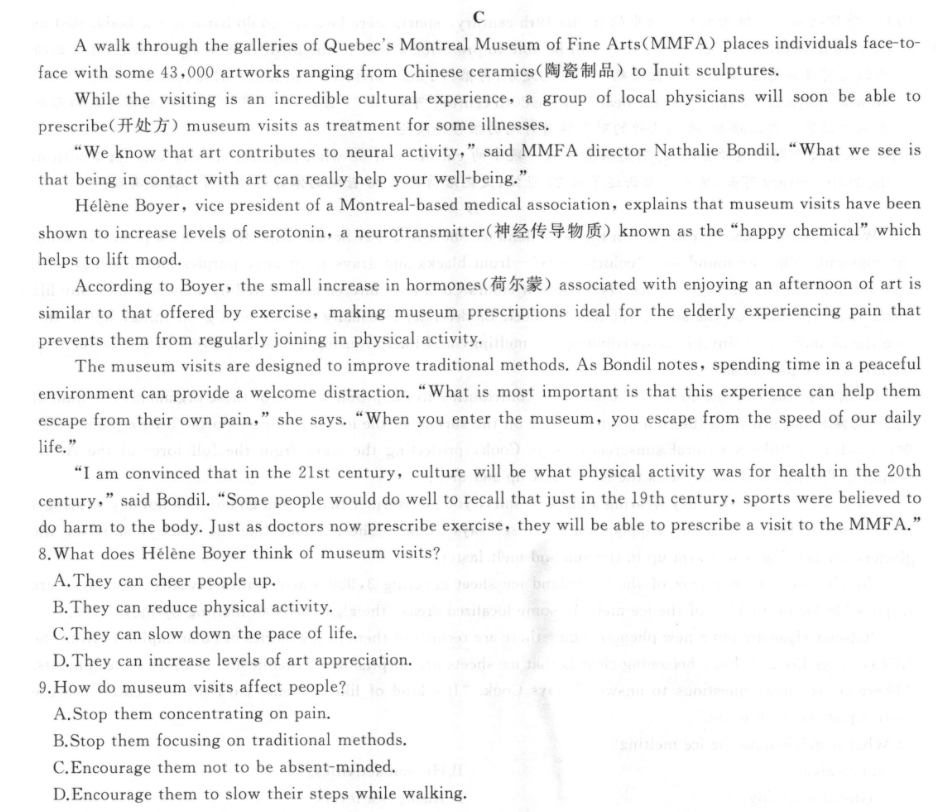
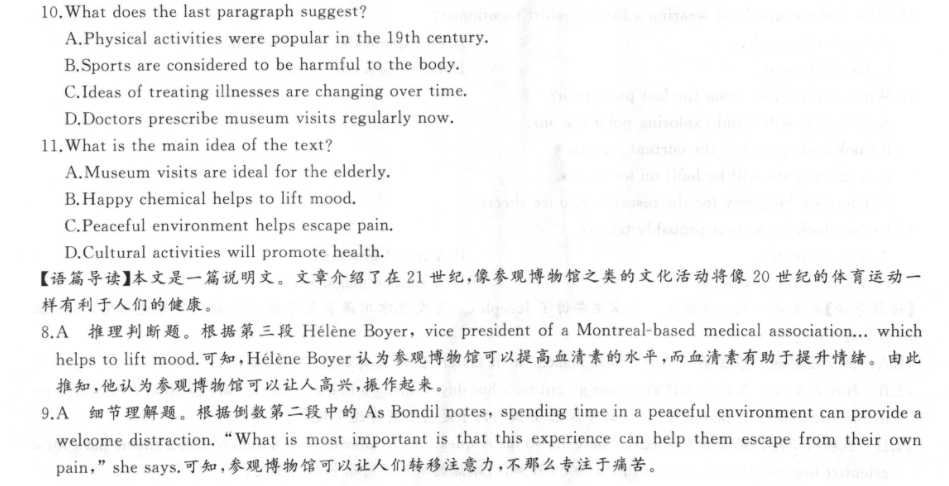

CA walk through the galleries of Quebec's Montreal Museum of Fine Arts(MMFA)places individuals face-to-face with some43,000 artworks ranging from Chinese ceramics(陶瓷制品)to Inuit sculptures.While the visiting is an incredible cultural experience,a group of local physicians will soon be able toprescribe(开w处方)museum visits as treatment for some illnesses."We know that art contributes to neural activity,"said MMFA director Nathalie Bondil."What we see isthat being in contact with art can really help your well-being."Helene Boyer,vice president of a Montreal-based medical association,explains that museum visits have beenshown to increase levels of serotonin,a neurotransmitter(神经传导物质)known as the“happy chemical'”whichhelps to lift mood.According to Boyer,the small increase in hormones(associated with enjoying an afternoon of art issimilar to that offered by exercise,making museum prescriptions ideal for the elderly experiencing pain thatprevents them from regularly joining in physical activity.The museum visits are designed to improve traditional methods.As Bondil notes,spending time in a peacefulenvironment can provide a welcome distraction."What is most important is that this experience can help themescape from their own pain,she says."When you enter the museum,you escape from the speed of our dailylife.”"I am convinced that in the 21st century,culture will be what physical activity was for health in the 20thcentury,"said Bondil."Some people would do well to recall that just in the 19th century,sports were believed todo harm to the body.Just as doctors now prescribe exercise,they will be able to prescribe a visit to the MMFA."8.What does Helene Boyer think of museum visits?A.They can cheer people up.B.They can reduce physical activity.C.They can slow down the pace of life.D.They can increase levels of art appreciation.9.How do museum visits affect people?A.Stop them concentrating on pain.B.Stop them focusing on traditional methods.C.Encourage them not to be absent-minded.D.Encourage them to slow their steps while walking.10.What does the last paragraph suggest?A.Physical activities were popular in the 19th century.B.Sports are considered to be harmful to the body.C.Ideas of treating illnesses are changing over time.D.Doctors prescribe museum visits regularly now.11.What is the main idea of the text?A.Museum visits are ideal for the elderly.B.Happy chemical helps to lift mood.C.Peaceful environment helps escape pain.D.Cultural activities will promote health.【语篇导读】本文是一篇说明文。文章介绍了在21世纪,像参观博物馆之类的文化活动将像20世纪的体育运动一样有利于人们的健康。8.A推理判断题。根据第三段Helene Boyer,vice president of a Montreal-based medical association.whichhelps to lift mood.可知,Helene Boyer认为参观博物馆可以提高血清素的水平,而血清素有助于提升情绪。由此推知,他认为参观博物馆可以让人高兴,振作起来。9.A细节理解题。根据倒数第二段中的As Bondil notes,.spending time in a peaceful environment can provide awelcome distraction."What is most important is that this experience can help them escape from their ownpain,”she says.可知,参观博物馆可以让人们转移注意力,不那么专注于痛苦。l0.C推理判断题。根据最后一段中的in the l9 th century,sports were believed to do harm to the body.Just asdoctors now prescribe exercise,they will be able to prescribe a visit to the MMFA.可知,在l9世纪,体育运动被认为对身体有害,而现在医生给病人开运动处方;再根据I am convinced that in the2 Ist century,culture willbe what physical activity was for health in the20 th century可知,在21世纪,文化将像20世纪的体育运动那样有益于健康。由此推知,疾病治疗的观念随着时间的推移而改变。ll.D主旨大意题。通读全文,特别是根据最后一段中的culture will be what physical activity was for health inthe20 th century可知,文章主要讲述了在21世纪,文化活动将像20世纪的体育运动那样对健康有益。
